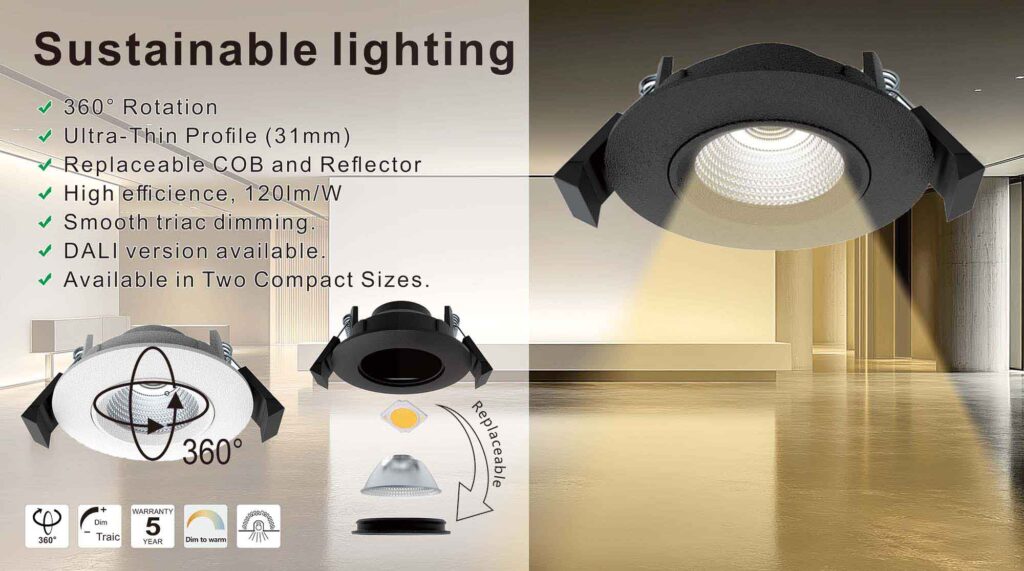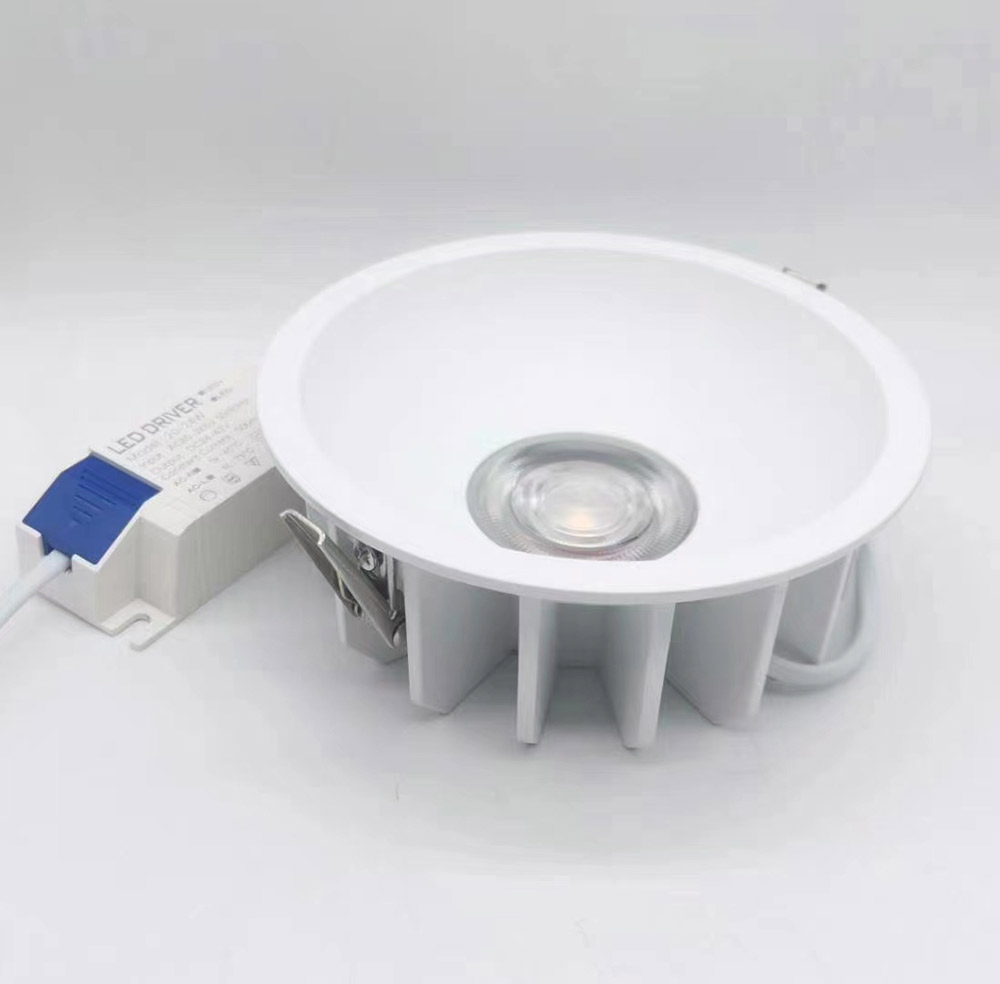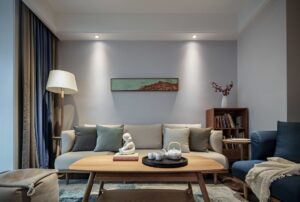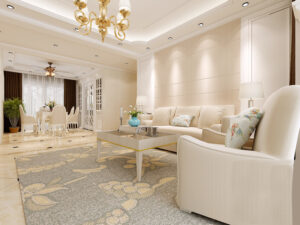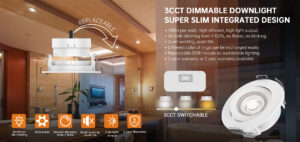Choosing the right downlight for your space is a vital decision that impacts both the functionality and atmosphere of your interior environment. Downlights are a popular lighting solution across Europe, favored for their ability to provide clean, unobtrusive illumination.
Among the many options available, fixed downlights and adjustable tilt downlights stand out as two primary types, each offering unique benefits tailored to different lighting needs.
This comprehensive guide will explore the distinctions between these two downlight types, their applications, and how to select the best option for your project in 2025.
Downlights are recessed or surface-mounted light sources installed into ceilings, providing focused or ambient illumination without occupying visual space. They have become a staple in residential, commercial, and hospitality lighting due to their sleek design and energy-efficient LED technology.
As lighting standards evolve, particularly in Europe, the demand for high-performance, customizable downlights increases. Understanding the differences between fixed and adjustable tilt downlights can help you optimize lighting design while complying with the latest energy and safety regulations.
Fixed Downlights: Simplicity and Uniformity
Fixed downlights are designed with a stationary light source. Once installed, their beam direction remains constant, providing consistent, uniform lighting. This makes them ideal for general ambient lighting in spaces such as living rooms, hallways, offices, and bedrooms.
Their minimalistic design ensures a clean ceiling appearance, which aligns with modern European aesthetic preferences for subtlety and refinement.
Advantages of Fixed Downlights
- Ease of installation: Fixed downlights require less precise positioning, reducing installation time and costs.
- Cost-effectiveness: Their simpler design typically means a lower upfront price compared to adjustable models.
- Uniform illumination: They produce consistent light distribution, ideal for general lighting needs.
- Low maintenance: Fewer moving parts mean less wear and tear over time.
Limitations
- Lack of flexibility: Fixed downlights cannot be redirected, limiting their use for accent or task lighting.
- Potential for shadows: In areas requiring focused light, fixed downlights may not provide adequate illumination.
Adjustable Tilt Downlights: Versatility and Control
Adjustable tilt downlights feature a pivoting mechanism that allows the light beam to be directed where needed. This flexibility makes them perfect for accent lighting, highlighting artworks, architectural details, or specific zones within a room. They are widely used in retail, galleries, kitchens, and hospitality settings where dynamic lighting is essential.Advantages of Adjustable Tilt Downlights
- Directional lighting: Ability to focus light precisely on objects or areas.
- Dynamic ambiance: Adjust lighting angles to create mood or highlight features.
- Versatility: Suitable for both ambient and task lighting.
- Design appeal: Their functional design adds a layer of sophistication and adaptability.
Limitations
- Higher cost: More complex mechanics and design increase the price.
- Installation complexity: Requires careful alignment and sometimes professional installation.
- Maintenance: Moving parts may need occasional adjustment or repair.
Comparing Fixed and Adjustable Tilt Downlights
| Feature | Fixed Downlights | Adjustable Tilt Downlights |
|---|---|---|
| Beam Direction | Fixed, non-movable | Adjustable, pivoting head |
| Best Use | General ambient lighting | Accent and task lighting |
| Installation Difficulty | Simple and quick | More complex, may require professional help |
| Cost | Lower upfront cost | Higher upfront cost |
| Aesthetic | Minimalistic, uniform ceiling look | Functional with visible adjustment feature |
| Maintenance | Low, fewer moving parts | Moderate, moving parts require care |
| Energy Efficiency | High (LED options available) | High (LED options available) |
| Flexibility | Low | High |
Key Considerations When Choosing Between Fixed and Adjustable Tilt Downlights
Purpose of Lighting
Understanding the primary function of your lighting is essential. Fixed downlights excel in providing general ambient light that evenly illuminates a room. Adjustable tilt downlights are better suited for highlighting specific features or providing task lighting in areas like kitchens or workspaces.Room Characteristics
- Ceiling height: For standard ceiling heights (2.4 to 3 meters), fixed downlights with wider beam angles (around 60°) can provide sufficient coverage. Adjustable tilt downlights are advantageous in spaces with higher ceilings or where focused light is required.
- Room size: Larger rooms benefit from a mix of fixed downlights for ambient lighting and adjustable tilt downlights for accentuating areas.
- Room function: Living rooms and bedrooms typically use fixed downlights for soft, uniform light. Kitchens, galleries, and retail spaces often require adjustable tilt downlights for targeted illumination.
Beam Angle and Light Distribution
The beam angle determines how light spreads from the downlight. Fixed downlights usually come with fixed beam angles, commonly around 40° to 60°, suitable for ambient lighting. Adjustable tilt downlights allow you to change the beam direction but usually have similar beam angle ranges.| Beam Angle Category | Degree Range | Typical Use |
|---|---|---|
| Very Narrow Spot | 5° – 15° | Highlighting small objects |
| Narrow Spot | 16° – 25° | Accent lighting |
| Medium | 25° – 40° | Task lighting |
| Wide Flood | 41° – 60° | General ambient lighting |
| Very Wide Flood | 60° – 120° | Broad area illumination |
Energy Efficiency and Compliance
With the ENERGY STAR Downlights Specification Version 1.0 taking effect in January 2025, lighting products must meet stricter energy efficiency and performance criteria. Both fixed and adjustable tilt downlights now commonly use LED technology, which offers superior energy savings and longevity compared to traditional lighting. The European Union’s Ecodesign regulations also mandate the phase-out of inefficient lighting, pushing the market toward LED downlights with high luminous efficacy (above 120 lm/W in some countries by 2025). When selecting downlights, ensure products comply with these standards to benefit from energy savings and qualify for certifications.Radians Lighting: Excellence in Downlight Design and Manufacturing
Radians Lighting is a prominent European manufacturer specializing in LED downlights, offering a wide range of fixed and adjustable tilt downlights tailored to meet diverse lighting needs. The company emphasizes customization, design innovation, and rigorous quality control, making it a trusted partner for lighting brands and dealers across Europe.Product Customization
Radians provides extensive customization options, including:- Beam angle adjustments to suit specific room sizes and ceiling heights.
- Color temperature variations from warm white (2700K) to cool white (5000K), enabling tailored ambiance.
- Dimmable options compatible with various control systems.
- Trim finishes such as white, black, brushed steel, and chrome to match interior decor.
Design and Quality Control
Radians integrates cutting-edge LED technology with meticulous design processes to ensure optimal light distribution, low glare, and energy efficiency. Their products undergo stringent testing to meet European standards, including IP ratings for moisture resistance and IC ratings for insulation compatibility.Product Categories Relevant to Downlight Selection
- Fixed LED Downlights: Designed for uniform ambient lighting.
- Adjustable Tilt Downlights: Offering directional lighting control.
- Dimmable Downlights: For mood and energy control.
- Anti-Glare Downlights: To reduce eye strain.
- Waterproof Downlights: Suitable for bathrooms and outdoor areas.
Technical Specifications to Consider
Lumen Output and Wattage
Lumens measure the amount of light emitted, while wattage indicates energy consumption. Modern LED downlights offer high lumens per watt, meaning bright light with low power use.| Wattage (W) | Typical Lumen Output | Application |
|---|---|---|
| 3W | 200 – 300 lm | Accent lighting, small spaces |
| 6W | 400 – 600 lm | Task lighting, kitchens |
| 9W – 12W | 700 – 1000 lm | General ambient lighting |
| 15W+ | 1200+ lm | Large rooms, commercial spaces |
Color Rendering Index (CRI)
CRI indicates how accurately a light source reveals colors compared to natural light. For residential and commercial spaces, a CRI of 80 or above is recommended, with 90+ preferred for retail or gallery settings.IP and IC Ratings
- IP Rating: Defines protection against dust and water. IP20 is common for indoor dry areas, while IP44 or IP65 is used for bathrooms or outdoor installations.
- IC Rating: Indicates whether a downlight can be safely installed in contact with insulation, important for energy efficiency and fire safety.
Installation Tips and Best Practices
- Plan the layout: Determine the number and spacing of downlights based on room size, ceiling height, and desired light levels.
- Choose compatible dimmers: For dimmable downlights, ensure dimmers match LED specifications to avoid flickering.
- Consider beam angles: Use wider angles for ambient lighting and narrower angles for accent lighting.
- Professional installation: Especially for adjustable tilt downlights, professional installation ensures optimal alignment and safety compliance.
Case Studies: Choosing Downlights for Different Spaces
Residential Living Room
- Fixed downlights with 60° beam angle provide soft, even lighting.
- Use dimmable options to adjust ambiance.
- Add adjustable tilt downlights near artwork or reading areas for focused light.
Commercial Retail Store
- Install adjustable tilt downlights to highlight merchandise.
- Use fixed downlights for general floor illumination.
- Select high CRI (90+) to enhance product colors.
Hospitality (Hotel Lobby)
- Combine fixed downlights for ambient lighting with adjustable tilt downlights to accent architectural features.
- Choose anti-glare models to enhance guest comfort.
- Use dimmable downlights for mood control during different times of day.

